
adjust font size

Were the “gay men ritually smoked out” of the Schwules Museum? – A ritual and its reception.
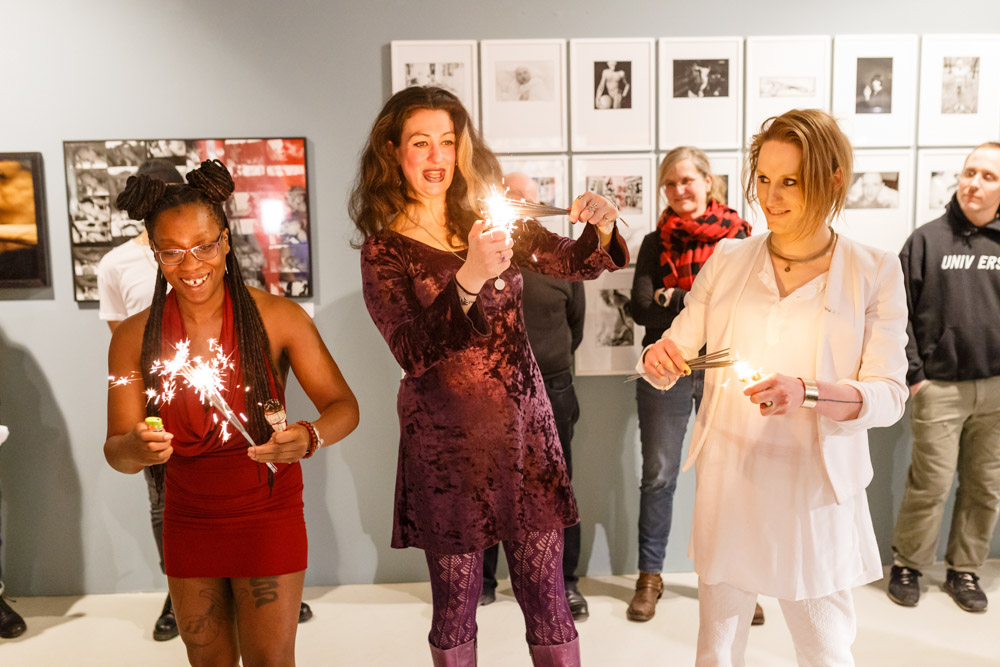
The 12 Moons Film Lounge opened with a New Moon Ritual. The 12 programs of the film lounge were supposed to change in a moonly rhythm at every new moon in 2018. Ritual is a long-standing part of queer-/feminist cultures, the same as collective activism, queer and feminist theory, art and culture, healing and celebration – all of what we were going to present within the YEAR OF THE WOMEN*. I asked Sadie Lune if she could take the lead for the night and we invited Caritia and Nika Fontaine to join us with their own practice.
The Schwules Museum hosted three exhibitions during that time whose last weeks on show overlapped with the start of the YEAR OF THE WOMEN*: Fascination Sex: The Theorist & Activist Martin Dannecker by Patsy L’Amour laLove, Fenster zum Klo. Public Toilets & Private Toilets by Marc Martin, and Change of Tapestry by Wolfgang Theis. I contacted all three beforehand personally with an email (10.1.2018) in which I informed them of the details of the night: the ritual “around the moon and the feminine”, the use of incense, performing in their exhibition spaces which “will not interfere with any of your installations and your artworks, neither physically nor is there any intention of disrespect”, and the intention for the year “to energize the whole museum and to invite all the things that will happen during the ‘new’ year”. All three curators agreed wholeheartedly, wishing luck for the femininities to take space in the Schwules Museum.
From some members of the audience, we received very generous feedback. Some examples:
You opened quite a few layers. I hope they will be understood in the museum.
– B. (young gay man)
Congratulations! There has never been such a nice and welcoming atmosphere at the Schwules Museum since I am working here.
– C. (colleague)
The ritual also received a lot of critique. Already that evening a prominent gay man asked me if we wanted to fumigate the gay men out of the museum. Together with the Dyke Bar, the ritual became the most talked about element of the YEAR OF THE WOMEN*, and was mostly ridiculed. All further elements within the year that referenced the queer-feminist herstories of witchcraft in whatever form were eyed critically. Some examples:
Meanwhile at the Schwules Museum, the demarcation between gay and lesbian is celebrated in such a way that at exhibition openings 'the gay is first ritually smoked out' in order to represent the position of a lesbian world. Symbolically, this happened at the opening of the first film lounge in January, which heralded the 'Year of the Women*.'
–Mannschaft 6/2018–own translation
Im Schwulen Museum wird die Abgrenzung zwischen schwul und lesbisch mittlerweile dergestalt zelebriert, dass bei Ausstellungseröffnungen zunächst rituell ‚das Schwule ausgeräuchert wird‘, um die Position einer lesbischen Welt darzustellen. Symbolisch geschah das bei der Eröffnung der ersten Filmlounge im Januar, die das ‚Jahr der Frauen’ einläutete.
–Mannschaft 6/2018–original
At the beginning of the year, a representative of the Schwules Museum told me that the occult and spiritual will dominate the museum in 2018 as never before. That this threat is to be taken seriously is evident in the museum's program and the speakers who have been invited there.
The once emancipative project of the Gay Museum is increasingly becoming a playground for heterosexual hipsters who call themselves "queer" and a venue for abstruse spiritualist rituals.
The rooms of my exhibition "Fascination Sex" about Martin Dannecker, for example, were cleansed of evil / male energies by a magical ritual, and the "Dyke Bar" that opened in April unfortunately has nothing to do with lesbians, but refers to a (fantasized) ancient knowledge of witches.
–Public Post by Patsy L’Amour laLove, 17.5.2018 (last retrieved on 29.07.2022)–own translation
Anfang des Jahres teilte mir eine Verantwortliche im Schwulen Museum mit, dass das Okkulte und Spirituelle das Museum 2018 so stark prägen wird wie nie zuvor. Dass diese Drohung durchaus ernst zu nehmen ist, merkt man dem Programm des Hauses und den Referent_innen, die dort eingeladen werden, an.
Das einst emanzipativ angelegte Projekt des Schwulen Museums wird mehr und mehr zur Spielwiese heterosexueller Hipster, die sich als „queer“ bezeichnen, und zum Austragungsort abstruser spiritistischer Rituale.
Die Räume meiner Ausstellung „Faszination Sex“ über Martin Dannecker etwa wurden per magischem Ritual von bösen / männlichen Energien gereinigt und die im April eröffnete „Dyke-Bar“ hat leider nichts mit Lesben zu tun, sondern beruft sich auf ein (fantasiertes) uraltes Wissen von Hexen.
–Public Post by Patsy L’Amour laLove, 17.5.2018 (last retrieved on 29.07.2022)–original
In 2019 I informed Nika, Caritia and Sadie Lune about the public reception. Here, I can share some excerpts from a longer conversation with Sadie Lune.
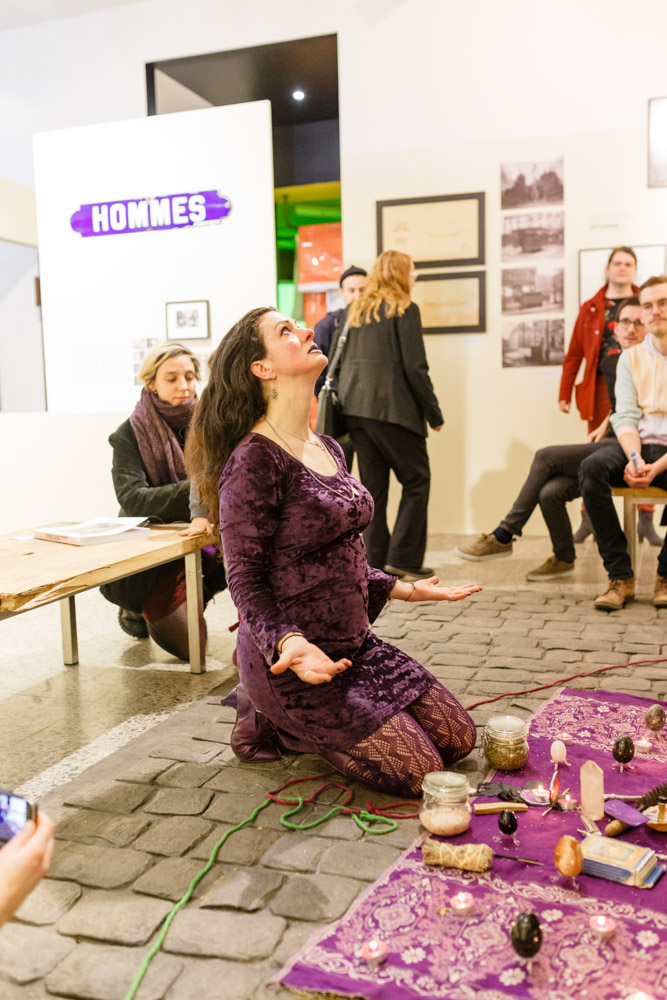
Sadie Lune:
Annie Sprinkle passed on what she calls the Public Cervix Announcement to me as a performance concept many years ago. I've done it as the Cervical Show and Tell, letting strangers peer into my vagina to see my cervix, in many countries and spaces around the world. I've done so much nudity and sexually explicit performance work, stuff like live piercing. I’ve given the audience a lit candle to drip wax on my body, etc. etc.
The fact that this small ritual was the most controversial performance I've ever done, as far as I understand, is blowing my fucking mind!
I did not feel in that moment the collective power and efficacy of ritual that I sometimes do where I'm like ‘yeah, okay, the spirit is high, this is working’. But what’s interesting, is that it seems in some ways it WAS effective (though not as lighthearted and joyfully as intended) in bleeding the misogyny out– incredibly painfully and slowly for more than a year. The ritual performance wasn’t about gay men at all, it was about misogyny.
And the reactions are quite shocking. The fact that it was something they found so offensive and problematic, that’s what gave it so much power. The power that we wanted from it was so much more minor, lighthearted: ‘Let’s just do the thing we are used to doing with this intention at the Schwules Museum, as a sweet symbol that we are opening an exhibit.’
I remember you asking me if I wanted to do or organize a ritual to open the 12 Moons Film Lounge and the YEAR OF THE WOMEN*. We invited other queer women, importantly women of color and trans women. Everyone involved has an aspect of ritual in their own life/art practice and was invited to bring their own ritual. So we were three performers from different positions and perspectives, who hold different spaces within the overlapping concepts of “queer” and “women”. We are lucky to know these artists who have a spiritual practice related to their creativity.
The idea of clearing the misogyny out of the space had nothing to do with getting rid of men at all, it was just not about that! Opening up a male dominated space to be more inclusive is not meant to push the men out. And while not all cis men or gay men are deeply misogynist, plenty of women and others are. I’m so saddened by how reductionist these critiques are.
I thought it was a sweet way to bring in this kind of performance art practice, combing spiritually-based ritual with live performance. That is what a lot of sex positive, feminist, queer performance artists are working with. I guess I'm also just super naive because I lived in San Francisco for 10 years and the connection between feminist, sex positive ritual and spirituality was so strong and common, especially in the performance art world there. It literally would not have occurred to me as it being exceptional. When you proposed it to me, I was like: ‘Oh, yeah, cute, kind of normal. You know, YEAR OF THE WOMEN*, very good, this is what we do, whatever. And only wanting to not piss on them or piss them off but to take the piss out maybe I would say. Not literally, I’m a fan of piss. This kind of thing could be done in any institution anywhere that is not a specific space for queer or women artists. And not even necessarily anything as kind of like monolithic sounding as YEAR OF THE WOMEN*, but in almost any sort of art space, from a feminist perspective. The institutional art world is misogynistic and always has been, the world of historical archive is the same – and that actually is not connected with homosexuality or gayness. This is just where these two things intersect. I'm not saying that gayness doesn't have, in many places, some sort of historical patriarchal ideology or whatever. I’m just saying that there was no interest in removing gay men or getting gayness out of there.
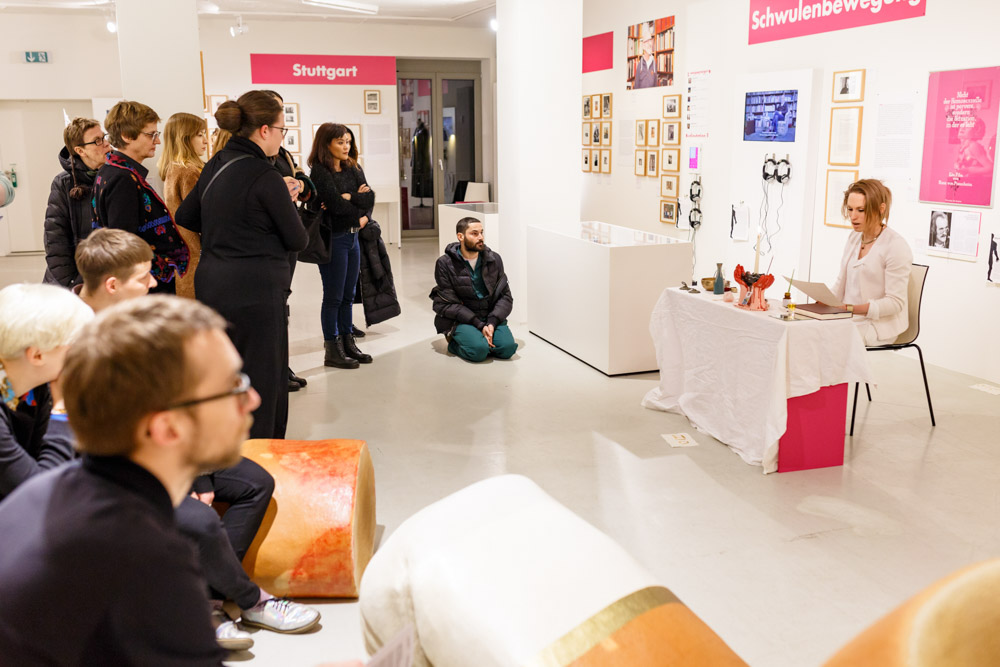
If anything, it was the opposite. It was more like: ‘Let’s clear out the misogyny so all the gay women and trans folx and non-binary and other queers have space to come in next to the cis-men’. And maybe there is also a language issue here, because in English the word 'gay' is no longer particularly gendered, and can be a shorthand for anyone under the rainbow, but especially for people who fuck or love similarly gendered people. My Deutsch grammar is not good enough to understand the gender implications of the word ‘schwules‘ and its suffix, if it’s specifically a male form or if women were ever called, or called themselves, schwul. When I first came to Berlin it was explained to me to mean 'gay' and I’m guessing ‘Schwules Schwein‘ is akin to faggot. So for me, as a queer genderqueer femme of Gen X with a US American background, to my knowledge of queer, especially political history, my understanding is that if I go somewhere called the 'Gay Museum', it is a place that may not be about “me” but is definitely for me. We have shared and intertwined histories, interests, struggles and should stand in solidarity. I’ve had work at the Schwules Museum before. I've been to that museum many times. Well, okay, there were people at the ticket office and working at the bar being kind of rude and not seeming super happy to see me and my queer kids and with me being a visible femme with babies in a LGBTQIA+ space…
But again, the fact that people are still talking about that little action is shocking to me, like really shocking. Why are they even taking it this hard?! It was not violent, not exclusionary. What are these weird made-up stakes?! I'm serious. It's the fucking Schwules Museum! This is not a legal battle. It's not even the Met or the biggest uni... it's the Schwules Museum! Chill, folks, chill! There wasn't a coven! There was nothing. It felt like a small symbol in that moment. It was gentle and quiet and small. And there was one woman per room. And then we came together in a vague circle with everyone else there. And my kid was there, do you remember? Everything was very improvised and soft and low stakes, the whole thing. It was not like a major siege force.
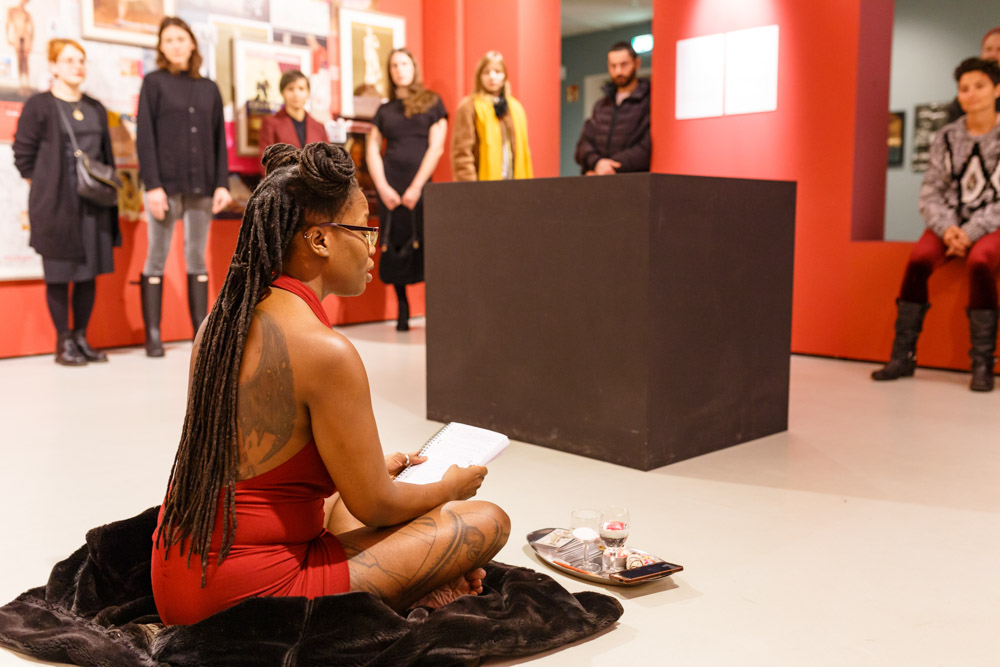
There was me, a queer parent, in another room a dominatrix who is black and was doing their ritual, and in another room a trans woman visual artist doing hers. That's part of who this community actually is. And to have us all there doing our thing at the same time, that's what felt like the real magic and the power. Taking a little glimpse of who was there shows there was the intention of indicating: ‘okay, and just so you know, you're welcome here, you and we are the “us” of this YEAR OF THE WOMEN*. You have space here. Your voice is important here. Your creativity is what we all want and need here. Please join us, even if this museum has felt too tight or unfriendly before, we will make room. That's what felt like the powerful magic of it.
What I wanted for the ending, which was not super successful, was to fill the room with the sound of women's laughter and to try to get everyone present to laugh with us. The intention of that was to bring some levity and joy and mirth and to not have it be about fighting, to not have it always be about struggle and to not have it be about suffering only, to unite us in joy and celebration, which it sometimes seems that cis gay men are more successful at than the rest of us. To be like: We can also have this be a celebratory feeling of queerness related to womenness and it's not all the well of loneliness, whatever, whatever. And that that kind of joyful, free sound and energy, but joined by every voice, not just women's voices, would have space. Also, we handed out sparklers to anyone in the audience and actually some people wouldn't take them. I don't remember that action being in any way exclusive or discriminatory. The intention certainly was, ‘let's all join together!’
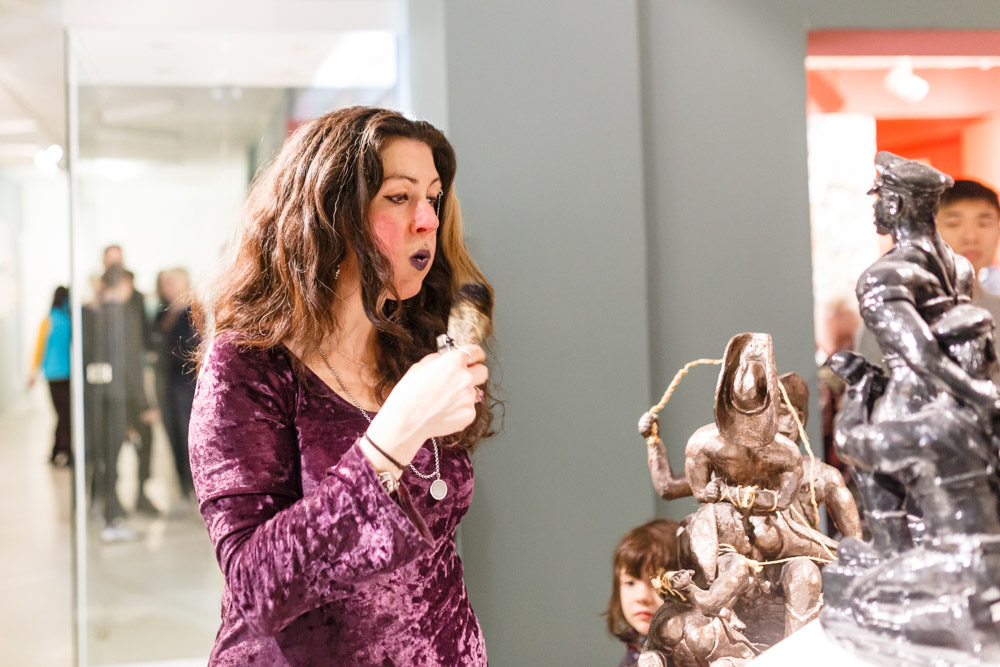
You told me some gay men commented harshly when I blew some smoke of the burning sage towards that one statue. I just can't conceive of what they think. I was standing in front of that statue with the two men connected in an embrace or something like that. An image like that is what makes my heart sing. This is where I feel like I'm still not over that in the world. I see two men holding hands on the street and I still tear up, no matter what. I'm fucking 41 and I've been living openly queer for over 20 years and raising my children in this ideology and lifestyle. This isn’t brand new to me and I didn't grow up in a place or time in the world where homosexuality or being trans* is punishable by death. But it's still important and impactful for me, every time. Depictions of open gay love still go straight to my heart – regardless of gender or anatomy. Men holding hands – it brings me so much joy. Misogyny is nothing related to expressions of male gayness. I mean, sure, there are definitely misogynist gay men– but also misogynistic women! But I'm not a separatist and I try to work towards mutual support and solidarity.
They’re really freaking out about this being religion. I don't think they understand what religion is. And this is where they feel like we're going back before the Enlightenment? Radical Fairies – it’s such a beautiful combination of witchcraft, environmental sustainability, community culture, queerness, femme, potential loving and gay male culture all in one term. My piece for COVEN Berlin's show, EXTRA+TERRESTRIAL in the YEAR OF THE WOMEN*, for instance, was about the history of witchcraft as having been twisted by religion and the state for misogynist oppression. The Spanish Inquisition and all of the different attacks on witches in Europe, especially in Germany, as well as in the States throughout history by Christians were basically an extension of misogyny around sexuality, around knowledge, around women, who in various ways didn't fit into a patriarchal power system. It was effective to put all women in line, to repress and scare them, and make sure that women had to stay very, very limited, scared and contained. And to me that's so linear in a way, not linear like a straight line but linear as in there is a line that weaves back and forth through time, through space, that connects all of these things, that connects knowledge, not the patriarchal knowledge, and sure, reason is important but that's not religion. If I want to get on my feminist theoretical high horse, I would say that Reason is the patriarchal religion of oppression of our current day. But esotericism is not religion and that's the whole point. I mean, maybe there are religions within it, but so much of it is anti and not based on a specific or cohesive religion, especially within the way that it was manifested in the show. I feel like if anything, it was more of a signifier of feminist community and perseverance and strength and knowledge than anything that's super cohesive or codified. We were all practicing from different belief systems and practices, which, if anything, signifies tolerance of multiplicities of ways to be: ways to be "women“, ways to be queer, ways to be spiritual, or use ritual, or to do live performance. It’s spacious, and certainly not an oppressive monolith of religion with unbalanced power and force. Religion has become excellent at using tools of oppression to condense its power, but limiting varied expressions of „religion“ or spirituality are just as oppressive and were also used historically by fascists.
Please, Schwules Museum people, look there is a book: It's old, it’s from the 70s, the year I was born, and it's called Witchcraft and the Gay Counterculture by Arthur Evans. Or look at The Faggots & Their Friends Between Revolutions by Larry Mitchell, or the work of artists like Ron Athey, movements like the Body Electric School. I have a lot of respect for the intellectual and conceptual lineages coming from openly gay cis men. I kind of wonder then, how much of this is, at the heart of it, just a conflict of a deeply German space and concept being infiltrated by an international one, same pot of ingredients, completely different recipe than in the US - completely different. Or is it about a stoic masculinity being “infected” by femininity? It’s true all of us participants in the ritual were long-hairs. Maybe all of it is true.
It's just such a deeply un-self aware misogyny that it freaks me out. Any amount of explicit inclusivity is seen as being a take over or a shut out, and that's incredibly upsetting. Gay German men of the Schwules Museum: I bet you fought like hell. And I bet you were fucking victimized. And I bet you were terrorized, and I bet it fucking sucks to be a Gay German man in the 70s with whatever threats were there and having been raised by war survivors as parents. This was probably a deeply traumatic and horrifying experience, but in 2019 you guys are class-wise, age-wise and structural institution-wise in a place of power, not necessarily ultimate power or the top of the power, but in a place of relative power. I would say in the Northwestern world being gay, visibly out, physically on the street, could be a cause for individual fear and threat, but it's no longer illegal. There's been so much progress made around being able to be free and open and just relaxed as a gay man in the world. And not only that, but you know for a generally white, and maybe otherwise privileged small subculture, you are really having huge places of power: money-wise, company-wise, even state-wise, etc. And to not see that?! Cis gay men – you are included in my vision and version of queer love and fight, are we in yours?
So then, in the extension of the same community, the boundary has moved out to the people who still don't have that, which is a lot of visibly trans* folx, gender non-conforming people, queers of color, intersex people, radical living people, sex workers, ‘Ausländer’, and poor, mentally ill, or isolated queers. This is where we are now and where some of our elders and ancestors have always been, same movement, same needs, same rights, same fight. But to not see that the shape and the color and the cultural texture needs to be broadened?! Because these are the people who are still suffering from the same ideas and the same laws, the same systemic structures. To not see that is really to perpetuate the oppression that you fought against that was traumatizing you and your beloveds, who I’ve considered my elders and ancestors. And, yeah, it takes some flexibility and some change. But, what the fuck?! If they can't see or hear the difference between gay men and misogyny, what does that say? Exactly what kind of messages is that?
Sadie Lune was interviewed by Vera Hofmann on the 19th of January, 2020.
The text was finalized on July 20th, 2022.
Copy editing: Victoria Anderson
All photographs by André Wunstorf
